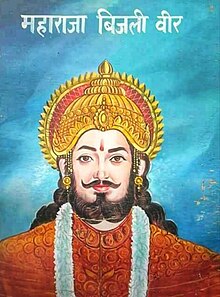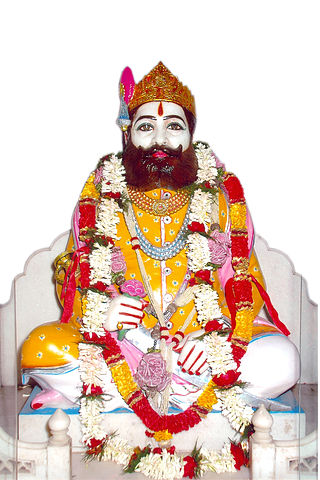| Maharaja Bijli Pasi महाराजा बिजली पासी | |
|---|---|
| Maharaja of Bijnor | |
 | |
| Religion | Shaivism, part of Hinduism |
Maharaja Bijli Pasi was a king from the Pasi community, According to popular belief, he ruled part of what is now Uttar Pradesh.
| Maharaja Bijli Pasi महाराजा बिजली पासी | |
|---|---|
| Maharaja of Bijnor | |
 | |
| Religion | Shaivism, part of Hinduism |
Maharaja Bijli Pasi was a king from the Pasi community, According to popular belief, he ruled part of what is now Uttar Pradesh.
Historical evidence for the existence of a king named Bijli Pasi is lacking. However, in 2000, the Department of Posts, Government of India issued a commemorative stamp about him. The move was influenced by the caste upliftment movement of Pasis under the leadership of Dalit leader Ram Vilas Paswan. According to the stamp, Bijli Pasi founded the city of Bijnor in Uttar Pradesh.It is said that he consolidated his position when northern India was divided into several small states prior to the fall of the mighty empires of the past. [1]
The assertion of Bijli Pasi gave voice to the claims of Dalits that in the past there were Dalit kings and that they had a glorious history just like upper castes. The warrior image of Maharaja, often seen upon the walls of various Dalit communities (especially people of Pasi caste) was designed as per the suggestion of Kanshi Ram, the founder of Bahujan Samaj Party. He wanted the image to contain the features of five Sikh gurus, who are also worshipped by Dalit communities to date. The specific feature of those gurus is visible in Maharaja's image, upon careful examination. [2]

Dalit, also previously known as untouchable, is the lowest stratum of the castes in India. Dalits were excluded from the four-fold varna system of Hinduism and were seen as forming a fifth varna, also known by the name of Panchama. Dalits now profess various religious beliefs, including Hinduism, Buddhism, Sikhism, Christianity, Islam. Scheduled Castes is the official term for Dalits as per the Constitution of India.

Kanshi Ram, also known as Bahujan Nayak or Manyavar or Saheb, was an Indian politician and social reformer who worked for the upliftment and political mobilisation of the Bahujans, the backward or lower caste people including untouchable groups at the bottom of the caste system in India. Towards this end, Kanshi Ram founded Dalit Shoshit Samaj Sangharsh Samiti (DS-4), the All India Backward and Minorities Communities Employees' Federation (BAMCEF) in 1971 and the Bahujan Samaj Party (BSP) in 1984. He ceded leadership of the BSP to his protégé Mayawati who has served four terms as Chief Minister of Uttar Pradesh.

Chamar is a Dalit community classified as a Scheduled Caste under modern India's system of affirmative action. Historically subject to untouchability, they were traditionally outside the Hindu ritual ranking system of castes known as varna. They are found throughout the Indian subcontinent, mainly in the northern states of India and in Pakistan and Nepal.
Chuhra is a Dalit caste in India and Pakistan. Populated regions include the Punjab region of India and Pakistan, as well as Uttar Pradesh in India, among other parts of the Indian subcontinent such as southern India. Their traditional occupation is sweeping, a "polluting" occupation that caused them to be considered untouchables in the Hindu caste system.
Ravidassia or the Ravidas Panth is a sect of Sikhism based on the teachings of Ravidass, who is revered as a Waheguru.
The Mallaah are the traditional boatmen and fishermen tribes or communities of North India, East India, Northeastern India and Pakistan. A significant number of Mallah are also found in Nepal and Bangladesh. In the Indian state of Bihar, the term Nishad includes the Mallah and refers to communities whose traditional occupation centred on rivers.
Mazhabi Sikh is a community from Northern India, especially Punjab region, who follow Sikhism. The word Mazhabi is derived from the Arabic term mazhab, and can be translated as the faithful. They live mainly in Indian Punjab, Rajasthan and Haryana.

Jhalkaribai was a woman soldier who played an important role in the Indian Rebellion of 1857. She served in the women's army of Rani Lakshmibai of Jhansi. She eventually rose to a position of a prominent advisor to the queen, Rani of Jhansi. At the height of the Siege of Jhansi, she disguised herself as the queen and fought on her behalf, on the front, allowing the queen to escape safely out of the fort.

The Nishad are a Hindu caste, found in the Indian states of Bihar and Uttar Pradesh.

Agrahari, Agraharee or Agarhari is an Indian and Nepali Vaishya community, They are the descendants of legendary king Agrasena. Predominantly, they are found in the Indian state of Uttar Pradesh, Madhya Pradesh, Jharkhand, Chhattisgarh and Terai region of Nepal.
The Dhanuk is an ethnic group found in India. In Bihar where they are significantly present, they have been categorised as the "lower backwards", along with several other caste constituting 32% of state's population. In recent times they have been identifying themselves with the Kurmi caste along with the Mahto of Chhotanagpur. In Bihar, they are considered as a sub-caste of the Mandal caste and are often found using Mandal surname. In recent times, there has been attempt to forge a socio-political alliance between them and the twin castes of Koeri and the Kurmi, as a part of Luv-Kush equation.
The Khatik, are an ethnic tribe found in the Indian subcontinent, mainly modern-day India, Pakistan and Nepal. They are one of the most widespread community in South Asia. Khatik have a population of approximately 10 millions and are located mainly in New Delhi, Haryana, Rajasthan, Madhya Pradesh, Uttar Pradesh, Maharashtra, Telangana, Andhra Pradesh and Himachal Pradesh.

The Pasi is a Dalit (untouchable) community of India. Pasi refers to tapping toddy, a traditional occupation of the Pasi community. The Pasi are divided into Gujjar, Kaithwas, and Boria. They are classified as an Other Backward Class in Andhra Pradesh and Telangana. They live in the northern Indian states of Bihar and Uttar Pradesh.

Suhaldev or Suheldev was a legendary king from Shravasti, popularly known to have defeated and killed the Ghaznavid general Ghazi Miyan at Bahraich in 1034 CE.
Chetram Jatav was a freedom fighter who participated in the Indian Rebellion of 1857. He joined the mutiny on 26 May 1857 in the Soro region of Eta district, North-Western Provinces. Them were tied to a tree and shot.
Kori is an Indian caste, who were traditionally weavers. Other names for this caste include Kamal, Kamalvansi and Shankhawar.

Uda Devi Pasi was an Indian women freedom fighter who participated in the war on behalf of Indian soldiers against the British East India Company, during the Indian Rebellion of 1857. She was a member of the women's squad of Wajid Ali Shah, the sixth Nawab of Awadh.

"Chauharmal" or "Chuharmal" or "Veer Chauharmal" was a folk hero who was later apotheosized by the members of Dusadh caste. The story of Chauharmal within Dusadh folklore is an empowering message which gives the Dalit community a sense of victory over upper caste Bhumihars.
The name Pasi is composed of two words Pa and asi (sword), implying thereby one who hold a sword in his hand or in other words a soldier. Another etymology is that the name comes from the Sanskrit pashika, "one who uses a noose." The Pasi are said to have used nooses for climbing trees.
Sahlesh was a folk hero of the Dusadh caste in Nepal and India. He is believed to have been the ruler of the Biratnagar in what became Nepal. In some parts of North India. Sahlesh is respected by communities apart from the Dusadhs. In local culture, he is portrayed as a symbol of prowess, valour and benevolence. Dauna Malin is believed to be a beloved of Sahlesh, while his four assistants namely Chauharmal, Moti Ram and Karikant are also worshipped. Chauharmal is worshipped by Dusadhs of Bihar and is considered to be the military commander of King Sahlesh. Moti Ram and Karikant are considered as his brother and nephew, respectively. Biratnagar, which is considered to be the land of Sahlesh, houses one of the finest temple of King Sahlesh. Sahlesh is also known as Rajaji. They worship mainly Salhesh Maharaj or Rajaji and his associates. Within the Danuwar community, Salhesh is regarded as the royal wrestler of Danuwar King Kuleshwar Singh kingdom of Pakariya gadh, located in present day Siraha district of Nepal.